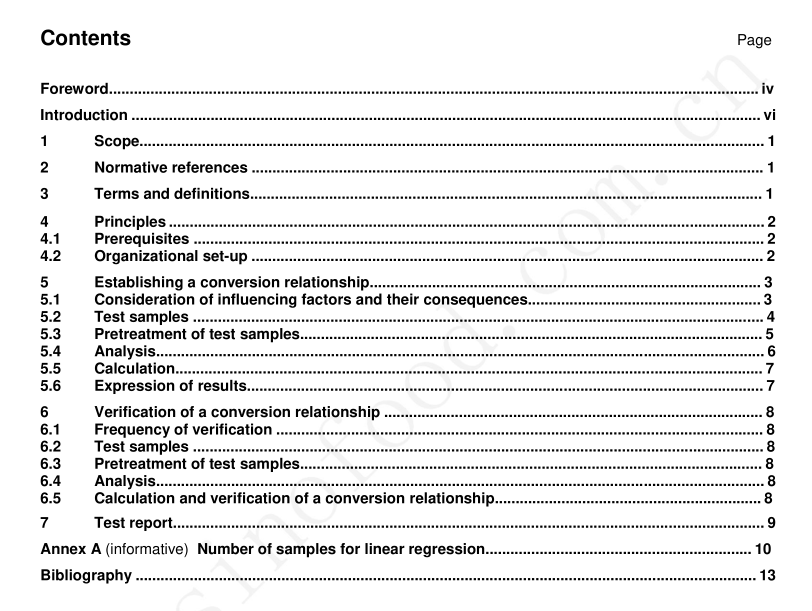BS ISO 21187 pdf download

BS ISO 21187 pdf download Milk — Quantitative determination of bacteriological quality — Guidance for establishing and verifying a conversion relationship between routine method results and anchor method results
anchor methodreference method
method of analysis internationally recognized by experts or by agreement between parties,and used, forinstance, in legislation when expressing official limits for bacteriological quality
NOTE lt is stressed that, in quantitative microbiology, any obtained value is only defined by the method descriptionapplied. This applies to any routine method as well as, for instance, to the standard plate count for the enumeration ofmicroorganisms. For the purpose of conversion, the term anchor method is preferred over the term reference method andtherefore is used throughout this International Standard.
3.3
analyte
component or property which is measured by the method of analysis
NOTE The analyte may be the microorganism,stained particles (e.g. microscopic count),components ofmicroorganisms (e.g. ipopolysaccharides), the result of their ability to multiply (e.g.colony-forming units) or their metabolicactivity (e.g.change in conductivityfimpedance).
3.4
organizing laboratory
laboratory, possibly appointed by the competent authorities, having the qualified staff and skills to organize, tocoordinate and to report on the outcome of the activities for the establishment or the maintenance of aconversion relationship
4Principles
4.1Prerequisites
For establishing and verifying a conversion relationship between the results of a routine method and theanchor method, the following prerequisites apply.
a) The routine method should have been validated according to ISO 16140 1. Procedures for sampling, test
sample preservation, sample transport, sample storage, sample pre-treatment, analysis and calculation ofresults should be documented,strictly standardized and controlled in agreement with ISOIEC 17025,EA-4/10, or comparable standards.
b)The anchor method should have been validated, documented, strictly standardized and controlled in
agreement with ISO/IEC 17025,EA-4/10 or comparable standards.
c)The protocol for the establishment of the conversion relationship and is verification should be
documented. lt should follow the guidelines of this International Standard. Approval by competentauthorities should be sought where the final aim is that results from a routine method are to be judgedagainst official limits stated in the anchor method units.
4.2Organizational set-up
The establishment and verification of a conversion relationship is based on the examination of test sampleswith both methods, covering the field of application and the spectrum of the samples as analysed using theroutine method.
b) The routine method is carried out in a number of laboratories and the anchor method is carried out in one laboratory (not necessarily a routine laboratory). In this situation, sub-samples must be prepared and transported from the location where the routine method is to be carried out to the laboratory where the anchor method is to be carried out, or the other way around. c) Both the routine method and the anchor method are carried out in a number of laboratories. As in b), the preparation and the transport of sub-samples must be properly considered. Due to the instability and variability of the bacteriological status of milk samples, the most robust conversion relationships will be obtained where the routine method and the anchor method are undertaken on the same test samples, at the same place, at the same time; i.e. situation a).
In all cases, the organizational set-up should include all the necessary provisions to guarantee that the obtained conversion relationship is representative of the circumstances under which the routine method is carried out and the resulting conversion relationship is later applied. The organizing laboratory should provide guidance to the collaborating laboratories. Furthermore, it should collect information on critical points in the procedure. All collaborators should be asked to record relevant information, such as details on the method(s) used, quality control data, and possible data about storage and transport conditions. 5
Establishing a conversion relationship
5.1 Consideration of influencing factors and their consequences
5.1.1 General A number of factors can influence the outcome of routine method or anchor method determinations, or both. The relative magnitude of the effects can differ between test samples and is not necessarily the same for both methods. This implies that certain factors can also influence the conversion relationship. In the evaluation of a routine method, all relevant factors should be identified and should be considered since it is necessary to cover the consequences of their variation in one conversion relationship, or otherwise to establish distinct conversion relationships.









